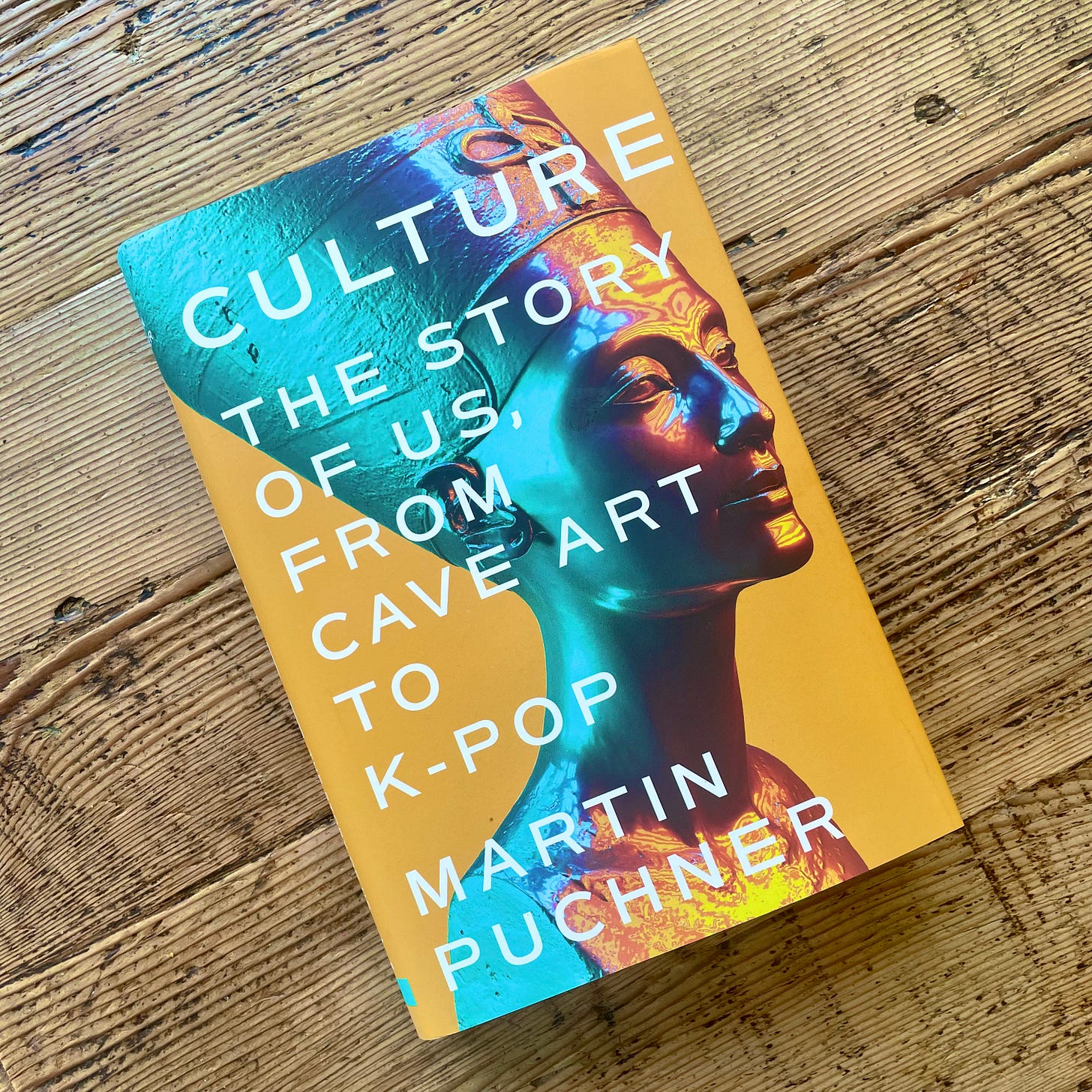‘Culture Is a Huge Recycling Project’
Is Appropriation Appropriate? Depends on What We Mean. Martin Puchner’s ‘Culture: The Story of Us from Cave Art to K-Pop’
It’s not hard to find examples of cultural appropriation across the media today, nor people decrying it. Just take one scorcher from a few years back (and before mentioning it, here’s hoping tempers have cooled a bit in the meantime): singer Adele’s Bantu knots. Dip into the social media and press coverage, and it’s all outraged critics and earnest defenders. “Cultural appropriation,” leveled the first group. “Cultural appreciation,” responded the second.
I suspect there stood a vast array of people in between, unbothered, uninterested and wishing the algorithm fairies would have served them up something different, perhaps Chinese Buddhism, hot yoga, or maybe the arts and letters of Roman society. Except, doh! Those are all examples of cultural appropriation, too. It’s cultural appropriation all the way down—even my reference to fairies.
Cultural appropriation usually refers to the adoption or exploitation of aspects of one culture by members of another. It presumes culture is a possession, something owned by one group and not others. A shorthand way of thinking: If a people developed a particular idea or practice, it’s theirs. If someone takes and runs with it for their own purposes, that’s appropriation.

The concept naturally plays into various forms of identity politics, and so it’s upsurprising it scandalizes many in the modern era. A Google Ngram of the term reveals a noticeable rise through the 1990s and a rocket-launch increase after 2012. But the fact that people seemed more or less unperturbed in prior generations means there must be another way of looking at the issue.
Harvard professor Martin Puchner presents such a view in Culture: The Story of Us, from Cave Art to K-Pop.
Culture as Innovation
“Culture,” says Puchner, “is made not only from the resources of one community but also from encounters with other cultures. It is forged not only from the lived experience of individuals but also from borrowed forms and ideas that help individuals understand and articulate their experience in new ways.”
Adopting and adapting cultural products from near and far is how cultures develop. They evolve, says Puchner “through circulation” and what he calls “a vast recycling project.” This reality has its origins in the central dynamic of all innovation.

“The creation of new ideas,” says Armand D’Angour, professor of classics at Oxford, “relies on a few basic principles: notably, the adaptation of existing elements, the cross-fertilization of disparate entities, and the disruption of previous conditions.”
When it comes to cultural evolution, those “disparate entities” are usually imports from different groups or societies. Puchner’s Culture presents more than a dozen case studies exploring the mashup of such entities across a wide range of cultures and timeframes: Egypt, Greece, Rome, China, the Near East, India, Japan, Africa, and beyond. I’ll focus on just a few below.
Who Owns the Ideas?
Greek culture survived the waning dominance of Hellenic political structures by its incorporation into Roman culture. The Romans adopted and adapted Greek knowledge, religion, and literature. Plays and philosophy were translated, read, and debated, expanding on their thought in the process.
Through the ongoing Byzantine empire—which was simply the continuation of the Roman to its inhabitants—those ideas, along with the very books that held them, persisted a millennium into the common era, such that the European Renaissance was less about Western genius reawakening than Western scholars becoming reacquainted with long-ignored ideas and newly acquainted with many others the Latin-Grecian language divide had previously sequestered from Europe’s learned class.
Bellicose Muslim invaders pushed Byzantine scholars into the more welcoming arms of the Florentines, Venetians, Milanese, and others. But this is only half the story. Byzantine power faded over centuries, and the Muslims had already been harvesting its ancient treasures of learning for nearly as long as there were Muslims.
Working with Eastern Christians, Muslim Arabs had been translating ancient Greek works into Syriac (the langauge of the Christians) and then into Arabic (which presented an easy jump from Syriac). The fruit of these labors, heavily focused on philosophy, mathematics, and medicine, found their way into Europe via returning Crusaders and manuscript hunters in places like Toledo, long before the Eastern migration of the Byzantines. (See Violet Moller’s The Map of Knowledge.)
Pagan Romans and then Christian Byzantines adopted the literature of the Greeks, which had been taken over by the Arabs, who amassed a large institution of learning known as the House of Wisdom where these ideas were copied, studied, critiqued, and advanced.
These examples should trip every alarm bell of the culture-as-property view. But who really owns these ideas: Greeks, Romans, Christians, Muslims? If you follow Pucnher’s approach, they all do. Same with us who read them today. And if everyone owns them, no one does. We could go so far as saying each producer—such as an author or scribe—owned the materials and labor they used to produce their work, but claims dry up after that.
Ideas roll downhill into the vast recycling bin. We might insist on some sort of timeline to extend that reversion to the masses, but even copyright law expires. It’s all fair game after that. Never mind our notions concerning ideas as property, especially as they developed, are relatively recent in world history, dependent upon the rise of a large legal class, which was more or less dependent upon another object of cultural appropriation: the printing press.
Tools of Change
Johannes Gutenberg is widely credited with the invention of printing with moveable metal type in the middle fifteenth century. No one knows exactly how he got the idea. Trade secrets are, after all, secrets. But we know he didn’t invent it.
The Chinese invented printing. The Koreans borrowed the advance and worked out moveable metal type two hundred years before Gutenberg turned out the first copies of his famous Bible. What’s more, as Puchner points out, the Chinese also contributed another essential technology to printing: paper. The new material came to Europe via the Middle East and Muslim Spain—another gift of the Arabs.
None of this diminishes Gutenberg’s accomplishment. The truth is invention is never the whole story. We also require innovation which develops and applies inventions in contexts where they find useful adoption. (See Matt Ridley’s 2020 book, How Innovation Works.) Without adequate adoption and subsequent improvement and optimization, new technologies come to nothing.
And this is one area where cultural borrowing provides an essential ingredient for technological advance. Technologies arising in one context may never have the opportunity for widespread adoption that another cultural context might provide. Any self-contained system requires the input of new ideas to change—those “disparate entities” Armand D’Angour mentions.
Dropped in the middle of Europe and developed by Gutenberg and his successors, printing detonated a centuries-long expansion of science, realignment of religious commitments, restructuring of political power, and the transformation of learning and literacy.
Is printing Chinese, Korean, or European? Yes. It’s also Japanese.
The Global Exchange
In the eighteenth and nineteenth centuries, Japanese artists pushed age-old Chinese woodblock printing in new directions, enabling multicolor depictions. “For each color,” says Puchner, “separate blocks had to be carved and keyed to the image, so that the different blocks could be printed on top of one another.” This created images of striking color with sharp edges, in sharp distinction from traditional Japanese water colors. The woodblock prints “suggested something entirely new.”
They were and they weren’t. Blending traditional ideas with native and imported European techniques in a new context—the entertainment district of Edo (Tokyo)—the colored prints served the new need for compelling promotional imagery and created a novel art form in the process.

Puchner points to Katsushika Hokusai’s The Great Wave at Kanagawa as a standout example of the form, not only for its technical skill but also for its subsequent influence. The Great Wave is one of the most famous images in the world, copied, mimicked, and parodied countless times. The wave also exemplifies the spread of Japanese art and sensibilities through global exchange it helped create.
Globalism accelerates cultural evolution because—back to D’Angour—it increases the accessibility of “disparate entities.” It also exacerbates people’s uneasiness because it unsettles the landscape and disrupts prior conditions at a pace some find challenging to manage.
If we hold to the view that cultural expressions constitute a form of property, we’re setting ourselves up for strife, much of it unnecessary. Cultures preserve; they also evolve and have always done so. Puchner’s study demonstrates that the process of adoption and adaptation represents culture’s basic mode of operation: holding onto some elements, incorporating new elements, and applying the novel outcomes in sometimes surprising ways. Historically construed, this is simply how cultures do their thing.
And it’s a liberating perspective. Puchner presents us not just a view of cultural evolution, but possibly an off-ramp from contentious identity politics. It’s there in his subtitle: We are all members of different communities, but we are also “us,” heirs to all the cultural adaptation that has gone before us and all dependent upon the dynamic for the vitality of our individual subcultures and whole societies.
The world as we know it is the product of cultural mixing and recycling. If we want to respond to disrespectful or distasteful examples of it—and we should—we’ll need a better tool than the idea of cultural appropriation.
Thanks for reading! If you enjoyed this post, please hit the ❤️ below and share it with your friends.
Not a subscriber? Take a moment and sign up. It’s free for now, and I’ll send you my top-fifteen quotes about books and reading. Thanks again!
Related posts:





Yes, yes, yes. Exactly, exactly, exactly. Thanks, Joel. Anyone who feels compelled to level accusations of appropriation would first do well to read your review and, better yet, the book itself, for healthy reminders of what constitutes "culture." Of course, when power, oppression, and/or mockery are evident, those are situations to decry (and modern sensibilities are sharply attuned to recognize those), but the vast, vast majority of expressions adopted and incorporated from other cultures into our own persist because they are valued, esteemed, and celebrated.
A wonderful summation. Fascinating to follow the movements — the innovations/inventions— through history. And almost impossible to make demarcations; the ‘blending’ can be so subtle.